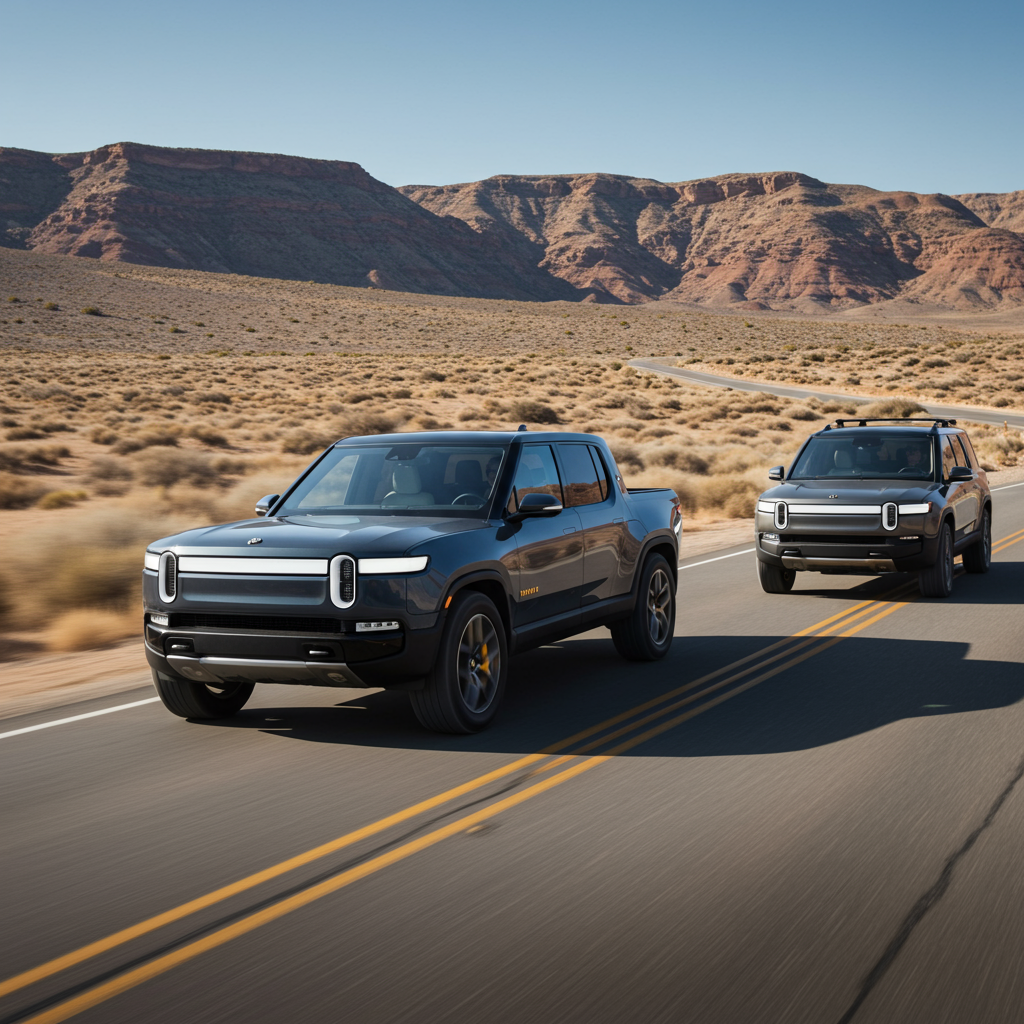The landscape of high-performance vehicles is rapidly shifting. Electric powertrains are redefining speed, but a rare few combine breakneck acceleration with the rugged capability once exclusive to traditional off-roaders. Enter the second generation of Rivian’s flagship R1 platform. Rivian’s latest quad-motor R1S SUV and R1T truck variants arrive, promising a blend of supercar pace and go-anywhere prowess. These models join the lineup alongside the impressive dual-motor versions.
Having spent time behind the wheel, it’s clear Rivian isn’t just making quick EVs. They’re building electric adventure vehicles that push the boundaries of what an SUV or truck can do. From shattering 0-60 mph times to tackling terrain that would stop most vehicles cold, the Quad-Motor R1 series aims to beat the competition in virtually any condition imaginable. This review dives into how Rivian achieves this remarkable duality.
The Core: Quad-Motor Prowess Unleashed
The key to the Quad-Motor R1’s extraordinary performance lies, unsurprisingly, in its name: four independent electric motors. Unlike most all-wheel-drive EVs that split power between front and rear axles via differentials, Rivian places one motor at each wheel.
This architecture is a game-changer. Traditional differentials introduce friction and can struggle with wheelspin, often requiring the vehicle to brake a slipping wheel to redirect power. The Quad-Motor setup eliminates mechanical differentials entirely. Each motor can be controlled individually. If one wheel loses grip, the system can instantly cut power to only that wheel without affecting the others. This provides unparalleled control over torque distribution.
Backing this advanced system is serious power. The Quad-Motor R1T and R1S deliver a staggering 1,025 horsepower (764 kW) and 1,198 lb-ft (1,624 Nm) of torque. This is enough to propel the R1T pickup from 0 to 60 mph in a blistering 2.5 seconds. The slightly heavier R1S SUV manages the same sprint in just 2.6 seconds. These figures are remarkable, especially considering the R1T weighs around 7,000 pounds (3,175 kg) and boasts an 11,000-pound (5,000 kg) towing capacity. The R1S comfortably seats seven. This combination of raw power, precise control, and practical utility is exceptionally rare.
Engineered for Excellence: Gen 2 Platform Updates
The advanced motor control is deeply integrated with Rivian’s new second-generation R1 platform architecture, introduced last year. This platform significantly simplified the vehicle’s underlying electronics. It reduced the number of ECU modules from 17 to just 7. This not only cuts complexity and wiring but also enables much more granular control over vehicle systems, including those four motors.
Beyond the core architecture, the Gen 2 updates bring other refinements. The air suspension tuning has been revised for better ride quality (though performance tires can still impact this). New, more powerful drive units and a reworked battery pack design contribute to efficiency and performance. A heat pump is now included, which should improve winter range efficiency. The vehicle features higher-definition cameras and sensors, powering enhancements to the Rivian Autonomy Platform+, including features like Enhanced Highway Assist.
A notable practical update is the adoption of the Tesla-style NACS (North American Charging Standard) port. This gives Rivian owners access to a significantly larger charging network, improving long-distance travel convenience.
On-Road Performance & Impressions
Behind the wheel, the R1 Quad-Motor feels every bit as potent as the numbers suggest. My initial time was spent in an R1T equipped with the optional Michelin Pilot Sport 5 S summer tires. The acceleration is truly eye-opening, akin to launching a sports car, not a large truck.
The ability to instantly vector power to each wheel contributes to a feeling of immense confidence, even when applying significant throttle through curves. The steering, while direct, offers minimal feedback, which slightly detracts from the sporty feel.
Rivian continues its minimalist interior approach, eschewing Apple CarPlay and Android Auto. This proved frustrating when streaming music via the truck’s data connection in areas with spotty service. Trying to access downloaded phone music felt surprisingly low-tech for a vehicle costing over $115,000.
However, a major highlight is the new RAD Tuner software feature. This allows drivers to adjust a wide array of vehicle parameters. You can tweak everything from suspension stiffness and throttle response to front-to-rear torque split and even roll stiffness. Each slider includes a clear graph and explanation. The changes are genuinely felt on the road. Dialing up the roll stiffness transformed the R1T from a relaxed cruiser to a noticeably more engaged handler. This level of customization is a refreshing change from the limited modes in many modern EVs.
On less-than-perfect pavement, the R1T with performance tires exhibited a surprisingly harsh ride and noticeable road noise. This suggests the sporty tire package, optimized for grip and acceleration, compromises comfort compared to what one might expect from a luxury-oriented EV.
Off-Road Capability & Impressions
Switching to an R1S fitted with the more aggressive Pirelli Scorpion off-road tires completely changed the vehicle’s personality. This setup was tested on challenging trails around Lake Tahoe. The R1S Quad-Motor ascended and descended obstacles that looked formidable even on foot.
The per-wheel motor control shines off-road. Over loose gravel, uneven ground, and steep inclines, the system constantly monitors grip. It precisely applies power to wheels with traction while cutting it instantly to those slipping or lifted in the air. This sophisticated traction management effectively surpasses the capability of traditional locking differentials. It makes navigating extreme terrain remarkably easy and confidence-inspiring, even for less experienced off-roaders.
Descending loose surfaces is also managed with exceptional control. The individual motors dynamically adjust regenerative braking at each corner. This ensures a smooth, straight descent without the vehicle sliding or losing composure.
Rivian’s unique tight-space maneuver, formerly Tank Turn, returns as Kick Turn. While engaging it requires a somewhat awkward button combination, the feature allows the R1 to perform impressive 360-degree spins on loose surfaces or pivot around tight corners. This capability helps compensate for the lack of rear-wheel steering, making the large vehicles more maneuverable on narrow trails.
The Crucial Role of Tire Choice
The experience on different tire packages makes one thing clear: your wheel and tire selection fundamentally shapes the personality of the Quad-Motor R1.
Performance Tires (e.g., Michelin Pilot Sport 5 S on 22-inch wheels): Unlock maximum acceleration (2.5s 0-60 mph) and on-road grip. Expect a firmer, potentially harsher ride and more road noise. Range may be slightly impacted compared to efficiency tires.
All-Season Tires (Standard on 21-inch wheels): Offer the best balance of range (up to 374 miles EPA, 400+ in Conserve mode), comfort, and capability for everyday driving, including light off-roading.
- Off-Road Tires (e.g., Pirelli Scorpion on 20-inch wheels): Maximize off-road traction and durability. Expect reduced on-road performance, slightly lower efficiency, and potentially a noisier ride.
- arstechnica.com
- www.usatoday.com
- tfltruck.com
- www.wired.com
Choosing the right package based on your primary use case is vital for satisfaction.
Range, Charging, and Practicality
Powering the Quad-Motor models is a large 140 kWh (usable) or 141 kWh Max battery pack. This provides an EPA-rated range of up to 374 miles with the efficiency-minded all-season tires. Rivian engineers suggest over 400 miles is achievable in the Conserve drive mode.
The inclusion of the NACS port significantly expands public charging options. While the R1 platform uses a 450-volt architecture, peak DC charging rates can reach up to 220 kW. This allows for adding substantial range relatively quickly, though a full charge will still take over an hour. Access to the Tesla Supercharger network is expected to further improve charging convenience.
Practicality remains a strong suit. The R1T boasts an 11,000-pound towing capacity, while the R1S can tow 7,700 pounds. Both feature useful storage like a generous front trunk (“frunk”) and the R1T’s unique horizontal “gear tunnel.”
Design Philosophy & Value
Rivian’s design ethos blends premium aesthetics with rugged functionality. The interior feels upscale yet ready for adventure. The Quad-Motor R1T starts around $115,990 and the R1S around $121,990. While a significant investment, the performance figures place them alongside supercars like the Lamborghini Urus (which is slower to 60 mph) while offering vastly more practicality and off-road capability. This unique blend of attributes represents a distinct value proposition for buyers seeking a single vehicle capable of extreme performance both on and off the pavement. The loss of the $7,500 federal EV tax credit for 2025 models adds to the overall price consideration.
Frequently Asked Questions
What makes the Rivian Quad-Motor R1T and R1S so fast and capable off-road?
The core technology is the Quad-Motor system, placing an independent motor at each wheel. This allows for precise, individual control over power delivery and regenerative braking, eliminating the need for mechanical differentials. This results in incredible torque vectoring for lightning-fast acceleration (2.5 seconds 0-60 mph for the R1T) and exceptional traction management off-road, easily handling obstacles and loose surfaces.
What are some notable technology and customization features found in the new Gen 2 Rivian R1 Quad-Motor models?
The Gen 2 platform features a simplified electrical architecture, enhanced driver assistance sensors, and standard NACS charging ports for wider network access. A key feature is the new RAD Tuner software. This allows drivers to deeply customize vehicle parameters like suspension stiffness, throttle response, torque split, and roll stiffness, significantly altering the driving feel.
How does tire choice impact the 2026 Rivian R1 Quad-Motor’s performance and ride quality?
Tire selection dramatically changes the vehicle’s character. Performance tires (e.g., on 22-inch wheels) enable the maximum 0-60 mph time but can result in a harsher ride and more road noise. All-season tires (e.g., on 21-inch wheels) offer the best range and comfort balance. Aggressive off-road tires (e.g., on 20-inch wheels) maximize grip on trails but reduce on-road performance and efficiency.
Ultimately, the most impressive aspect of Rivian’s new Quad-Motor R1T and R1S is their sheer versatility. They offer an intoxicating mix of supercar-level acceleration and extreme off-road capability. Few, if any, other vehicles on the market can credibly claim to master such a broad spectrum of performance. While areas like ride comfort on performance tires and infotainment features could still see improvement, the core engineering and capability of these electric adventure machines set a new benchmark for what’s possible in a truck or SUV.




